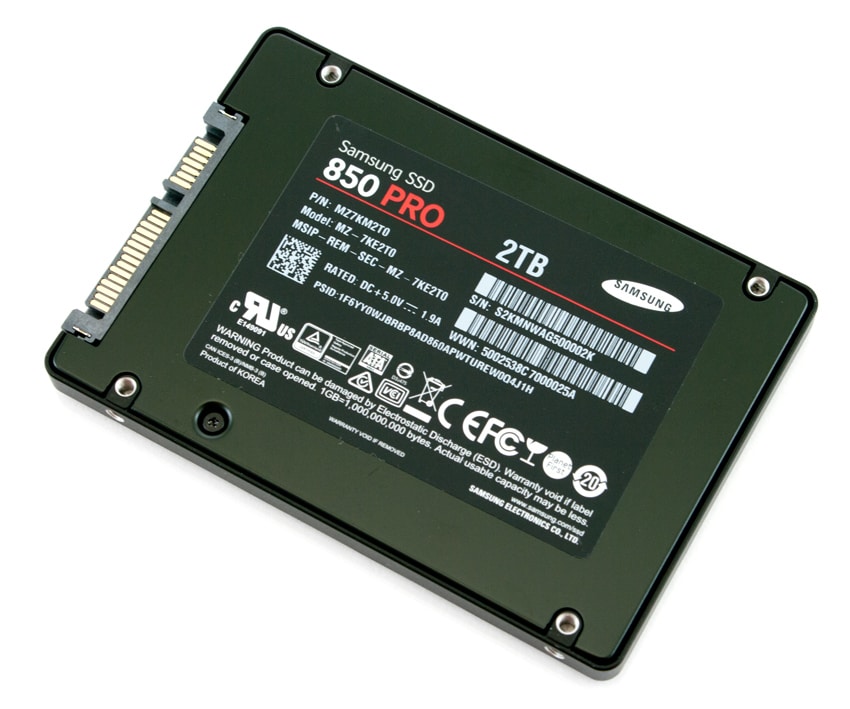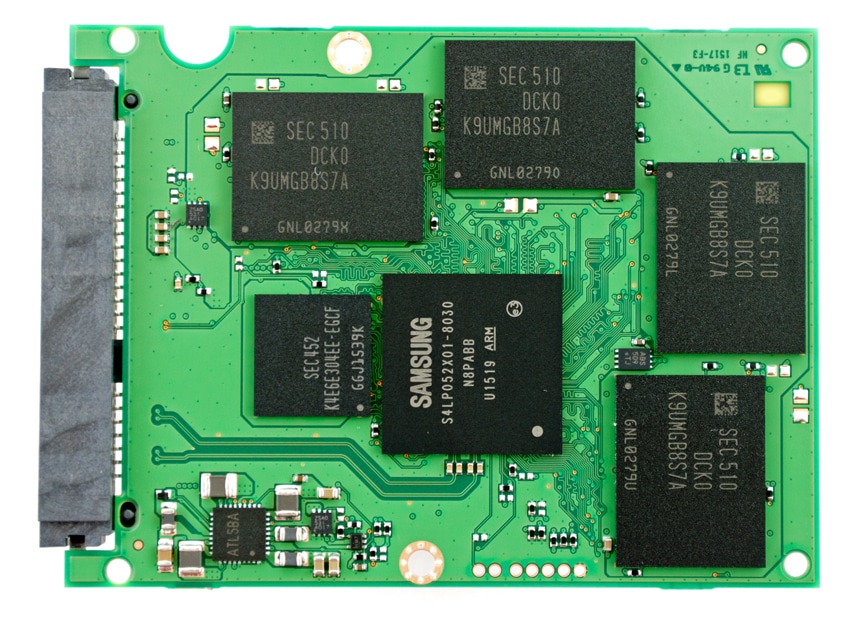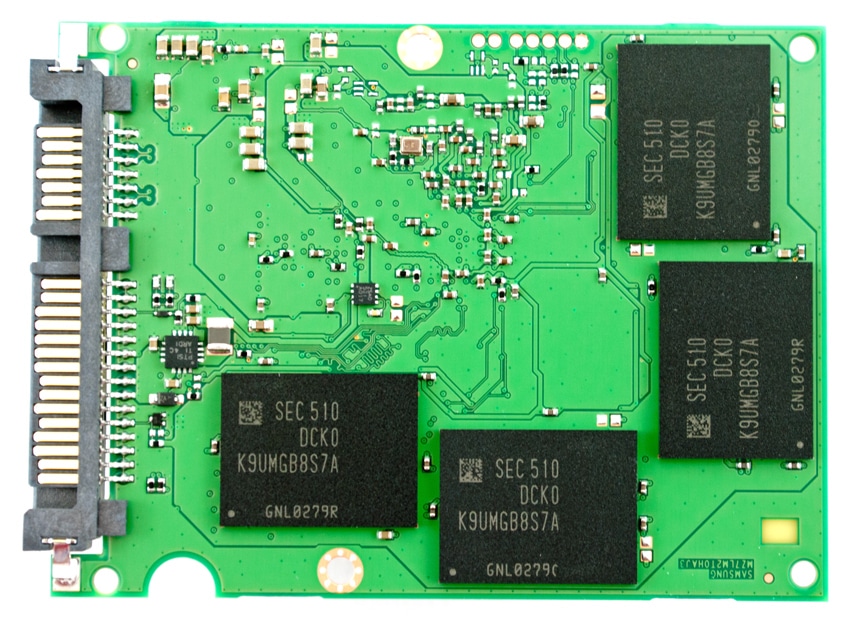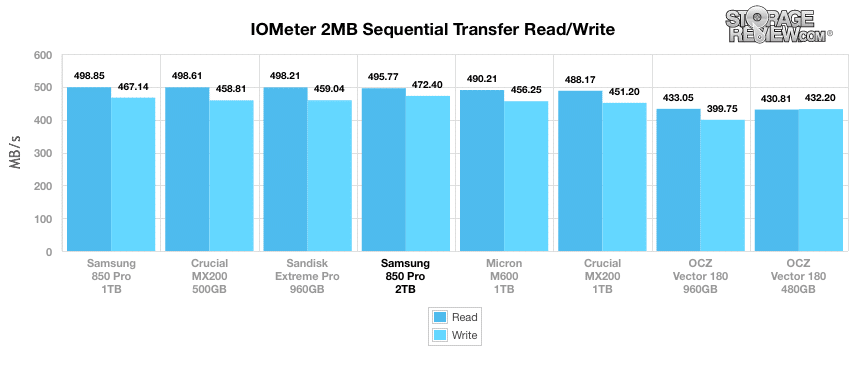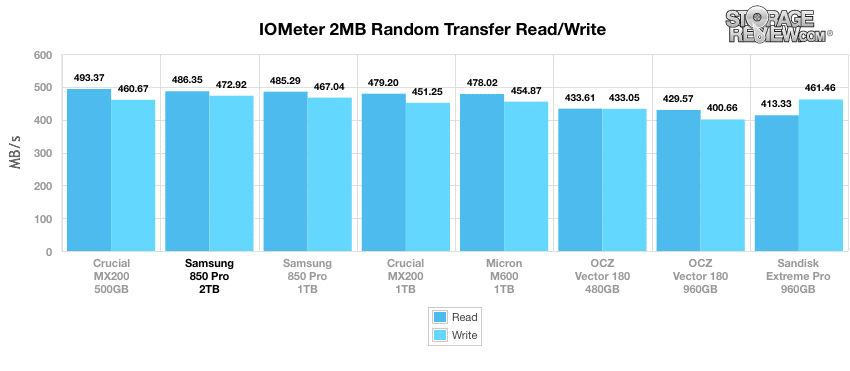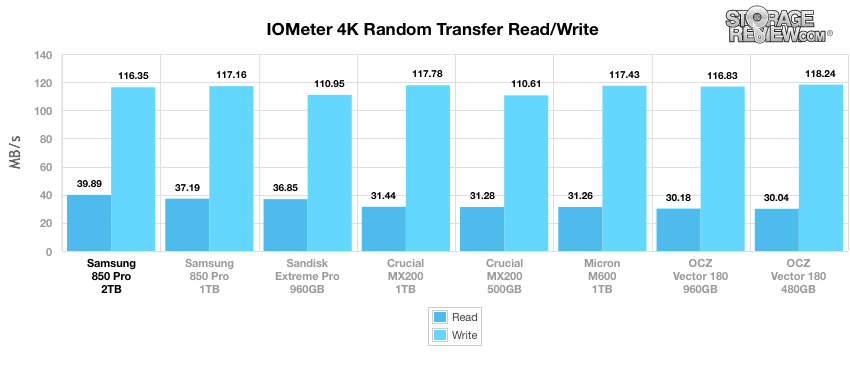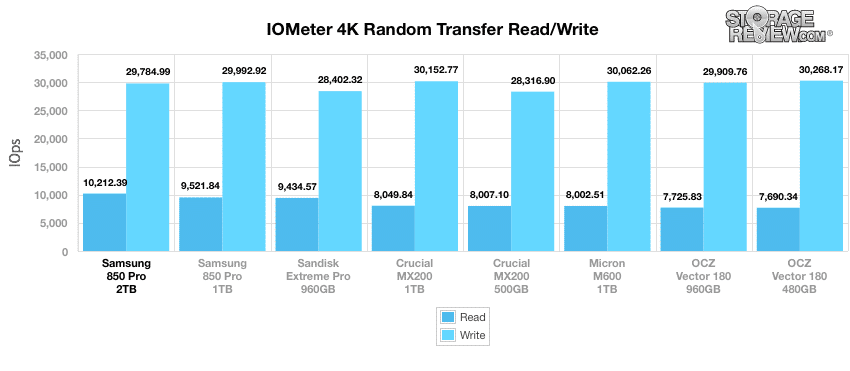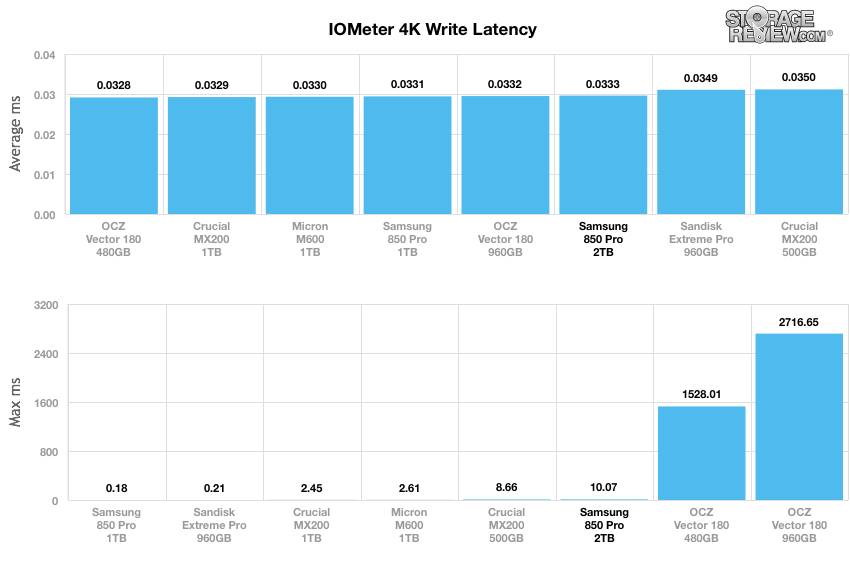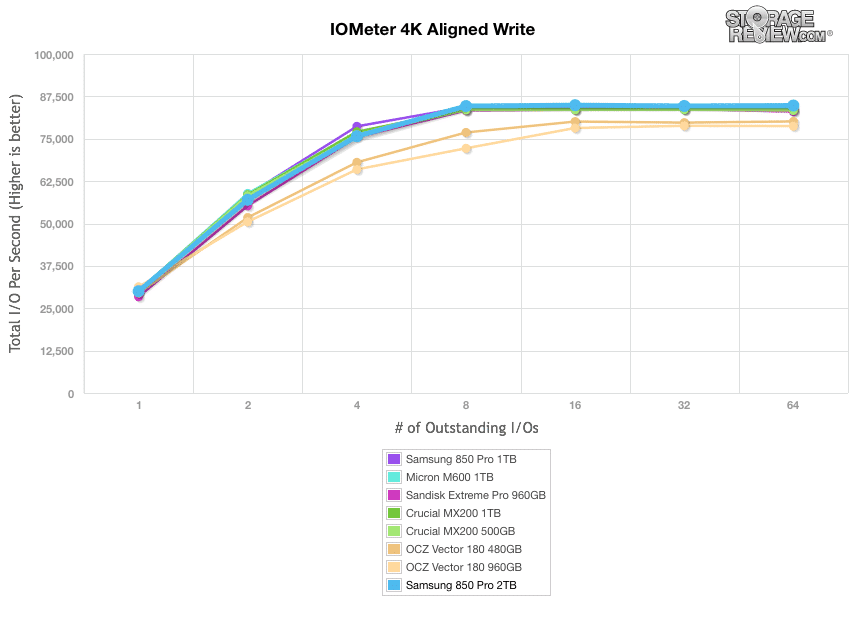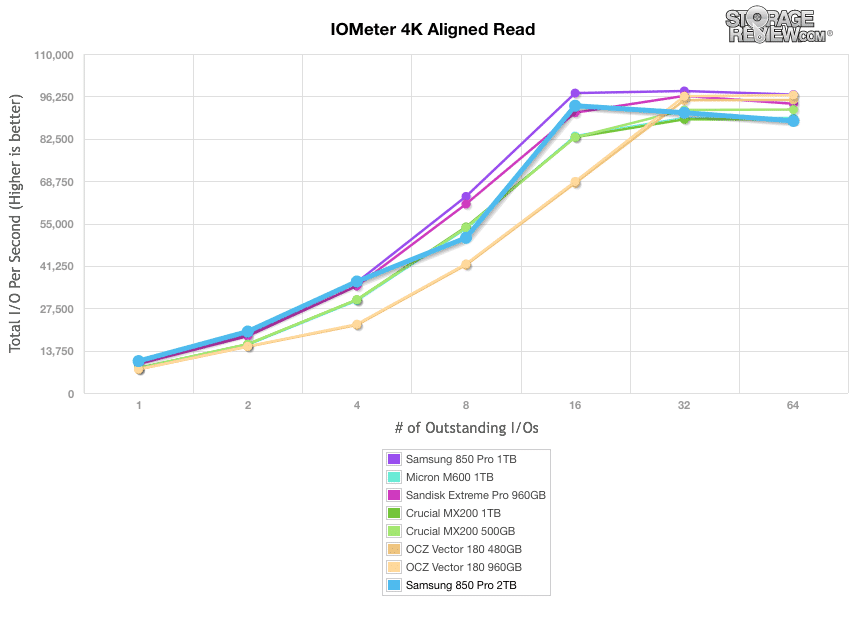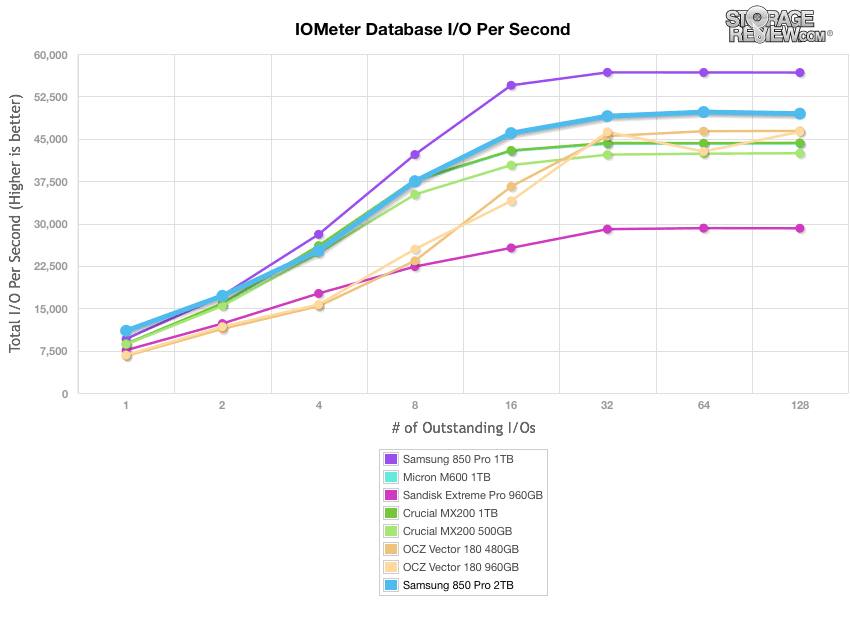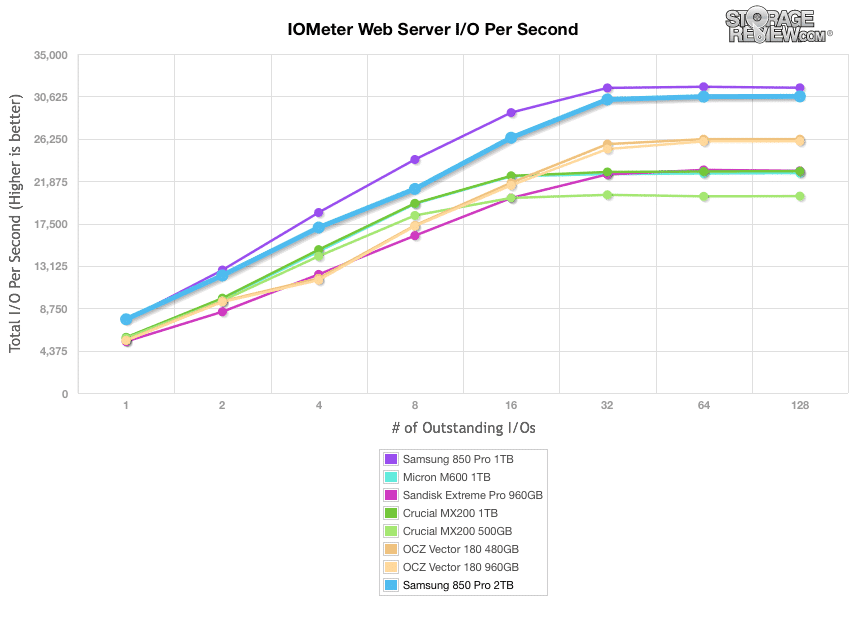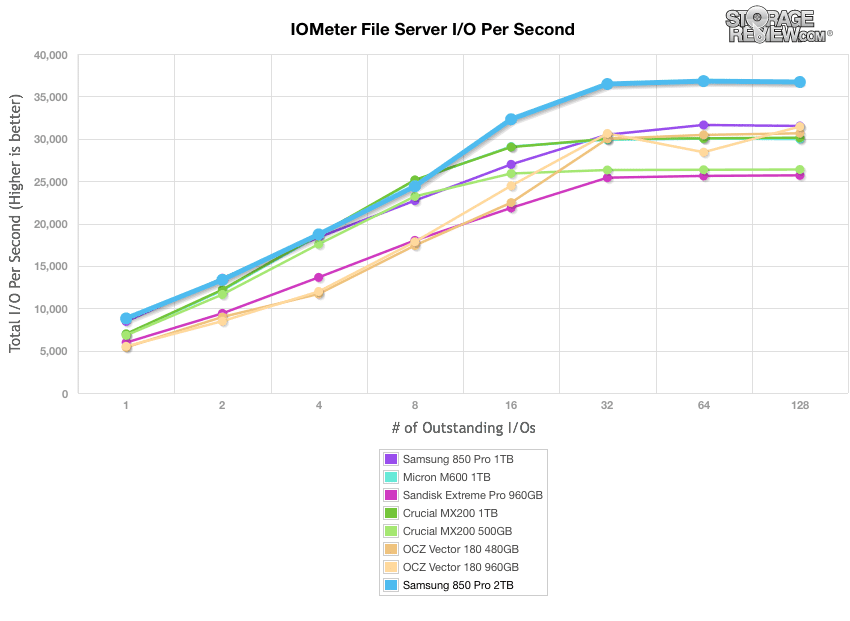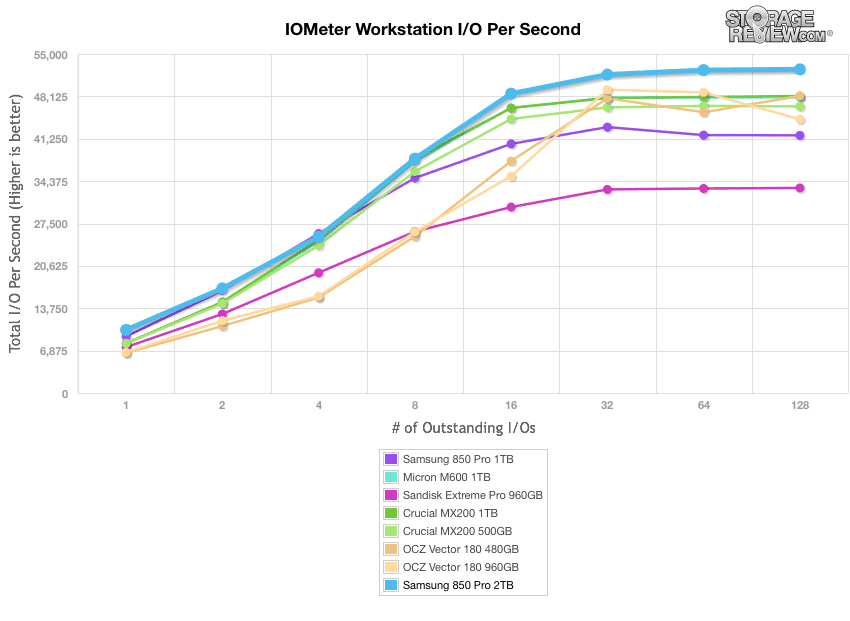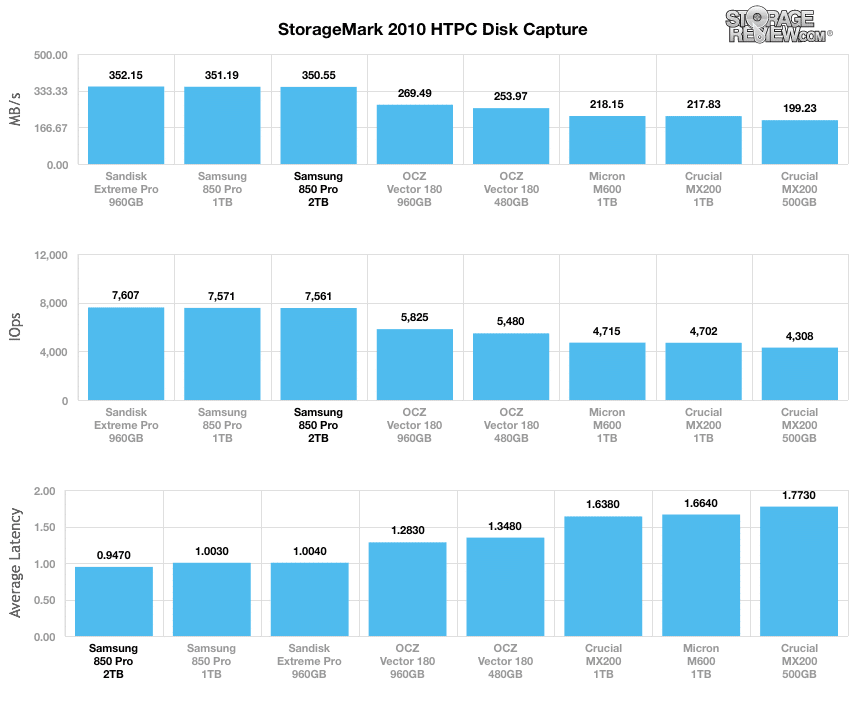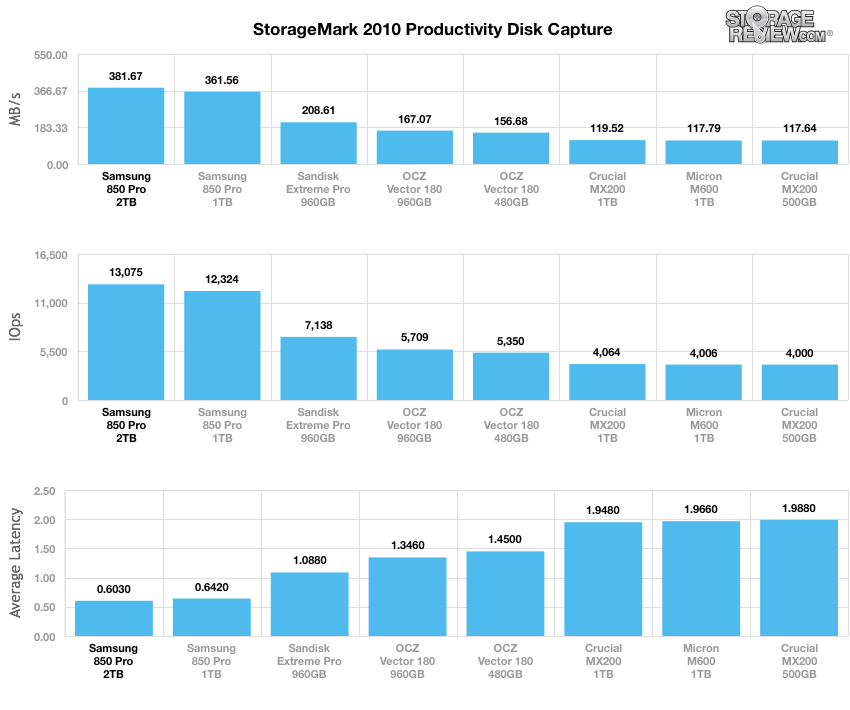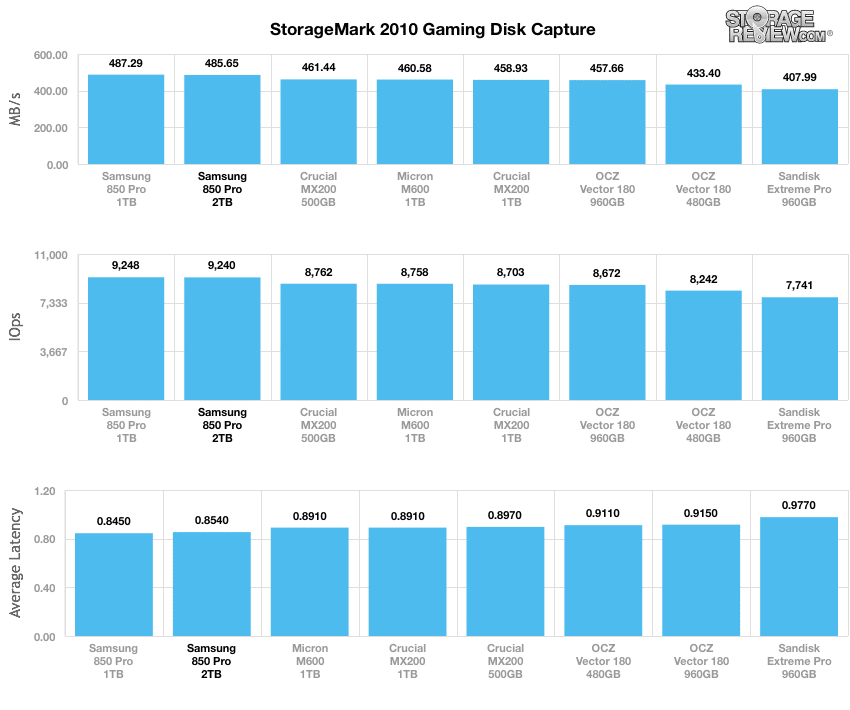
Today Samsung released a new addition to its 850 PRO SSD line, the SSD 850 PRO 2TB. This marks the largest capacity consumer SSD for Samsung and the first 2TB consumer SSD commercially available. Like the rest of the line, the new 850 PRO 2TB uses Samsung’s 32-layer 3D V-NAND 2bit MLC/3bit MLC. Samsung states that its 3D up to two times the density and write speed performance. The drive has 2GB of LPDDR2DRAM cache memory, SATA 6Gb/s interface, and comes with a 10-year warranty.
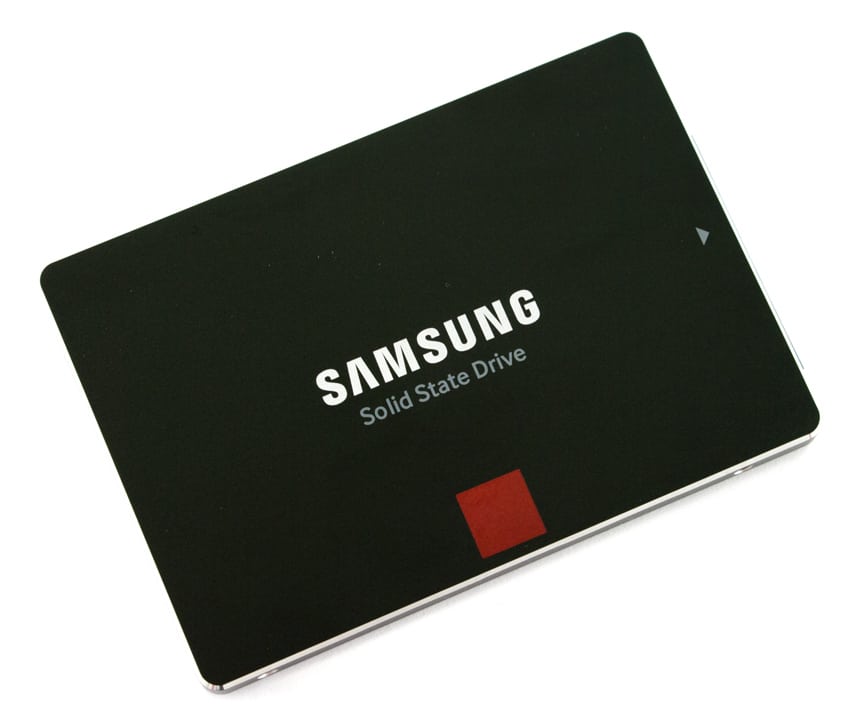
Samsung’s 850 PRO line is all about performance, and from our last review one can see that they can deliver on that performance. The latest drive also claims some pretty impressive numbers. On Sequential read speeds, Samsung claims the 2TB can hit 550MB/s and on sequential write it can hit 520MB/s. On 4K random tests the 850 PRO 2TB claims performance of 100,000 IOPS read (QD32) and 90,000 IOPS write (QD32). These are right about the same speeds that the lower capacity models claimed. The 2TB drive also has high reliability with 2 million hours MTBF and 300TBW. Samsung is aiming to take the performance of the 850 PRO line and bring it to the highest capacity drive that one can currently buy.
Like the other drives in the line, the 850 PRO 2TB comes with a 10-year warranty and a retail price of $999.99.
Samsung 850 PRO SSD Specifications (2TB)
- Capacities: 128GB, 256GB, 512GB, 1TB, 2TB
- Dimensions (LxWxH): 100 x 69.85 x 6.8 (mm)
- Interface: SATA 6Gb/s (compatible with SATA 3Gb/s and SATA 1.5Gb/s)
- Form Factor: 2.5 inch
- Controller: Samsung MHX controller
- NAND Flash Memory: Samsung 3D V-NAND 2bit MLC
- DRAM Cache Memory: 2GB LPDDR3
- Sequential Read: Max. 550 MB/s
- Sequential Write: Max. 520 MB/s
- Performance
- 4KB Random Read (QD1): Max. 10,000 IOPS
- 4KB Random Write (QD1): Max. 36,000 IOPS
- 4KB Random Read (QD32): Max. 100,000 IOPS
- 4KB Random Write (QD32): Max. 90,000 IOPS
- TRIM Support
- Garbage Collection
- S.M.A.R.T
- AES 256-bit Full Disk Encryption (FDE)
- TCG/Opal V2.0, Encrypted Drive (IEEE1667)
- Weight: Max. 66g
- Reliability
- MTBF: 2 million hours
- 300 Terabytes Written (TBW)
- Power Consumption
- Active Read (Average): Max. 3.3W
- Active Write (Average): Max 3.4W
- Idle: Max. 60mW
- Device Sleep: 5mW
- Temperature Operating: 0°C to 70°C
- Non-Operating: -40°C to 85°C
- Humidity: 5% to 95%, non-condensing
- Vibration: Non-Operating: 20~2000Hz, 20G
- Shock: Non-Operating: 1500G , duration 0.5msec, 3 axis
- Warranty: 10 years limited
Design and Build
The Samsung SSD 850 PRO 2TB model looks identical to its smaller capacities with its minimalistic, slim black/charcoal design comprised of a flat black top with Samsung branding and a simple “Solid State Drive” text. It is of 7mm z-Height form factor, allowing it support a variety of applications such as notebooks, desktops, and ultrabooks.
When flipping the drive over shows a sticker with all the key information about the drive. The side profiles are equipped with four screw holes to allow seamless mounting of the 850 PRO.
When looking under the hood, you will see the highly vertically integrated components, including the Samsung DRAM, Samsung V-NAND and Samsung SSD controller. The 2TB model uses the Samsung MHX controller (compared to the 1TB’s Samsung MEX) and supports a SATA 6Gb/s interface, though it is also compatible with SATA 3Gb/s and SATA 1.5Gb/s. Looking further inside the 2TB 850 PRO will show 8x 128GB 32-layer 3D NAND packages and 2GB of LPDDR3 memory.
Consumer Synthetic Benchmarks
All consumer SSD benchmarks are conducted with the StorageReview client testing platform. The comparables used for this review include:
- Samsung 850 Pro 1TB (SATA, 6Gb/s, Samsung MEX controller)
- Micron M600 1TB (SATA, 6Gb/s, Marvell 88SS9189-BLD2 controller)
- SanDisk Extreme Pro 1TB (SATA, 6Gb/s, Marvell 9187 controller)
- Crucial MX200 1TB (SATA, 6Gb/s, Marvell 88SS9189 controller)
- Crucial MX200 500GB (SATA, 6Gb/s, Marvell 88SS9189 controller)
- OCZ Vector 180 480GB (SATA, 6Gb/s, OCZ Barefoot 3 M00 controller)
- OCZ Vector 180 960GB (SATA, 6Gb/s, OCZ Barefoot 3 M00 controller)
All IOMeter figures are represented as binary figures for MB/s speeds.
In our first test, which measures 2MB sequential performance, the 2TB Samsung PRO posted an impressive 495.77MB/s read and 472.40MB/s write, the latter which was the top performer. This also placed it in the upper middle of the pack for reads (though only by 3MB/s), with the 1TB PRO model at the top of our leaderboards.
Moving to our 2MB random transfer performance tests, the 850 PRO ranked at the top of our leaderboard in writes once again with 472.92MB/s, while reads hit 486.35MB/s, which was just behind the Crucial MX200 500GB.
In our IOMeter’s random 4K read and write test the SSD 850 PRO drive measured best-of-class reads with 39.89MB/s while writes it 116.35MB/s. The 1TB PRO capacity reached 37.19MB/s read and 117.16MB/s write.
Our random 4k test pushes hard on the drives when looking at throughput. In this scenario, the 850 PRO a very impressive 10,212.39 IOPS read and 29,784.99 IOPS write, taking the top spot among the leaders in the read column, handedly beating out the other top consumer drives. As for the 1TB PRO capacity also fared very well with 9,521.84 IOPS read and a leading 29,992.92 IOPS write.
Comparing write latency, the 850 PRO posted an average latency with just 0.0333ms (it should be noted that this was the exact same latency as its 2TB EVO brethren) while its maximum readings fell behind a bit with 10.073ms though well above the performance of the Vector drives.
In our next 4K test, we move to a workload with 100% write activity, which scales from 1QD to 64QD. In the aligned write setting, the 2TB 850 PRO posted the best results of all the consumer drives with 30,027.63 IOPS in burst and 84,805.09 IOPS in the terminal. The 1TB model was hot on its trail with a range of 30081.91 IOPS to 84,178.54 IOPS
Moving on to our aligned read reading benchmark, the 2TB PRO recorded a QD1 IOPS of 10,367.53, though reaching only 90,956.16 IOPS in the terminal, which was noticeably less than that of its 1TB brother.
Our final consumer synthetic benchmarks compare the drives in a series of mixed server workloads with a queue depth from 1 to 128. Each server profile has a strong bias towards read activity, ranging from 67% read with the database profile to 100% read in the web server profile.
The database profile features a 67% read and 33% write workload focusing on transfers around 8K in size. Here, the 2TB PRO posted results just behind its 1TB brethren in the terminal with 49,435.73 IOPS; however, it posted an impressive, and class leading, burst speed of 11,007.53 IOPS.
Our next benchmark is the web server profile is read-only with transfer sizes ranging from 512B to 512KB. In this scenario, the 2TB PRO posted best-of-class performance throughout the entirety of the test, with a range of 7,612.45 IOPS to 30,624.37 IOPS.
The file server profile has 80% read and 20% write workload spread out over multiple transfer sizes ranging from 512-byte to 64KB. Again, the 2TB PRO showed class-leading results, with an impressive 8,796.66 IOPS in burst speeds and 36,697.92 IOPS at QD64, easily taking top spot among the other consumer drives.
The last profile looks at workstation activity, with a 20% write and 80% read mixture using 8K transfers. Here, the 2TB Samsung 850 PRO recorded another leading burst speed of 10,241.17 IOPS while the terminal ended with a whopping 52,511.70 IOPS.
Consumer Real-World Benchmarks
While the results of synthetic benchmarks are important to identify the key strengths and weaknesses of a drive, performance in these tests does not always translate directly into real-world situations. To get a better idea how the 2TB Samsung SSD 850 PRO will handle itself in the field we will chart StorageMark 2010 HTPC, Productivity, and Gaming traces against comparable drives. Higher IOPS and MB/s rates with lower latency times are preferred.
The first traced is based on use as a Home Theater PC (HTPC). The test includes playing one 720P HD movie in Media Player Classic, one 480P SD movie playing in VLC, three movies downloading simultaneously through iTunes, and one 1080i HDTV stream being recorded through Windows Media Center over a 15 minute period.
In our HTPC profile, the 2TB 850 PRO SSD posted 7,561.15 IOPS, 350.55MB/s and 0.947ms in average latency. The top overall performer here was the SanDisk Extreme Pro.
The next trace simulates disk activity in an office workstation or productivity scenario. This test includes three hours of operation in an office productivity environment with 32-bit Windows Vista running Outlook 2007 connected to an Exchange server, web browsing using Chrome and IE8, editing files within Office 2007, viewing PDFs in Adobe Reader, an hour of local music playback, and two hours of streaming music via Pandora.
In our Productivity trace, the 2TB Samsung 850 PRO SSD really picked up in performance, posting top, best-in-class results in every category: 13,074.89 IOPS, 381.67 MB/s, and 0.603ms in average latency.
The final consumer real-life benchmark simulates disk activity during gaming. This simulation taxes the drive’s read performance, with 6% write operations and 94% read operations. The test consists of a Windows 7 Ultimate 64-bit system pre-configured with Steam, with Grand Theft Auto 4, Left 4 Dead 2, and Mass Effect 2 already downloaded and installed. The trace captures the heavy read activity of each game loading from the start, as well as textures as the game progresses.
In this gaming profile, the 2TB PRO boasted impressive results once again, though it fell just shy of top spot behind its 1TB brethren.
Conclusion
The Samsung 850 PRO is a 2.5” SSD powered by 3D virtual NAND technology. The latest entry in the line is a 2TB model, which not only is the highest capacity drive in the 850 PRO line, it is also currently the highest capacity for the entire SSD market. The previous 850 PROs we tested have remained as the top performers we’ve seen in a 2.5” form factor. Samsung is looking to take this performance and bring it into higher capacity (in this case doubling the previous maximum capacity). The drive has a SATA interface and comes with a 10-year warranty.
Looking at performance in more detail, the 2TB Samsung 850 PRO posted both best-in-class, bar-setting numbers, particularly during our synthetic tests; however, it was sometimes outshone by its smaller 1TB capacity brother. In our 2MB performance benchmark, the 2TB model posted an impressive 495.77MB/s read and 472.40MB/s write, the latter which was the top performer, while random write performance hit another class leading 472.92MB/s. Reads were also right at the top of the leaderboard with 486.35MB/s, which was just behind the Crucial MX200 500GB SSD. In our IOMeter’s random 4K test, the SSD 850 PRO drive measured best-of-class read activity with 39.89MB/s while the throughput benchmark boasted results placing it at the top spot on the leaderboard once again. Though the 850 PRO posted the best results of all the consumer drives with 30,027.63 IOPS in burst and 84,805.09 IOPS in the terminal, in our 100% aligned write test, the 1TB model handedly beat out the 2TB model in aligned write. During our series of mixed server workloads, the 2TB 850 PRO recorded class-leading results in all profiles, with the exception of our database profile, which had a throughput in the terminal just behind its 1TB brother. In our last set of tests (consumer real-world), the 2TB 850 PRO drive continued its great performance, showing bar-setting numbers during our productivity trace with 13,074.89 IOPS, 381.67 MB/s, and 0.603ms in average latency.
With all of this considered, Samsung has released yet another best-of-class SSD on the market. The 2TB 850 PRO model has certainly followed the footsteps of its smaller capacity brethren, offering even better performance in many of our tested categories. Though very expensive, professionals and power-users should look no further when it comes to this drive if price is not an issue.
Pros
- Highest capacity SSD currently available
- Set a new bar in performance in many of our benchmarks
- Samsung pedigree with a 10-year warranty
Cons
- Much more expensive than a 2TB HDD
Bottom Line
The Samsung 850 PRO 2TB drive is a bar-setting SSD in both capacity and performance, offering power users arguably the best consumer drive on the market.

